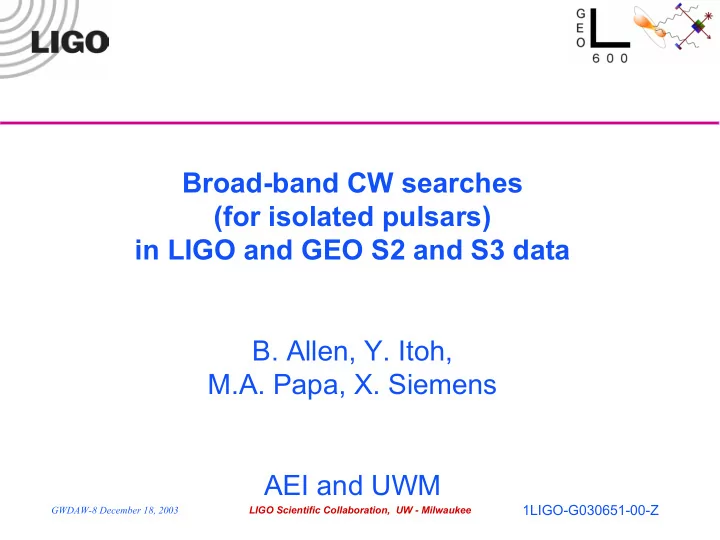

Broad-band CW searches (for isolated pulsars) in LIGO and GEO S2 and S3 data B. Allen, Y. Itoh, M.A. Papa, X. Siemens AEI and UWM 1LIGO-G030651-00-Z GWDAW-8 December 18, 2003 LIGO Scientific Collaboration, UW - Milwaukee
What’s new (compared to S1)? • S1: targeted search for a single pulsar J1939+2134 • S2/S3: moving towards a hierarchical CW search » Expand parameter space (but using coherent techniques) » Also developing hierarchical techniques in parallel • Two general types of CW search: » Short observation time (~ half-day) all-sky, no spindown parameters, 150- 450 Hz » Longer observation time, (perhaps) one spin-down parameter, small-area search (Galactic plane, SN remanents). There is a delicate trade-off between sensitivity, observation time (spanned and effective), parameter- space resolution, and source class. We hope to use grid techniques to employ thousands of CPUs for around a month. • Note that different choices might need to be made to produce the best upper limits. 2LIGO-G030651-00-Z GWDAW-8 December 18, 2003 LIGO Scientific Collaboration, UW - Milwaukee
Large-scale CW search with GriPhyN LIGO • First attempted for the SuperComputing 2003 meeting last month. S. Koranda is our liason with the computer scientists. • Entire S2 observation time, 200 Hz band, look at the Galactic Center • Used approximately 1600 CPUS in the LSC data grid: www.lsc-group.phys.uwm.edu/lscdatagrid/details.html » AEI (Merlin, 360 CPUs) » Birmingham (Tsunami, 200 CPUs) » Cardiff (160 CPUs) » Caltech (200 CPUs) » Penn State (312 CPUs) » UTB (Lobizon, 73 CPUs) » UWM (Medusa, 296 CPUs) • Also accessed some ‘non-LSC’ grid resources • Still doesn’t work as well as we want: Globus Job Manager has trouble managing 10 5 or 10 6 compute jobs 3LIGO-G030651-00-Z GWDAW-8 December 18, 2003 LIGO Scientific Collaboration, UW - Milwaukee
Modifications from S1 code • Internal loop to search over sky positions and spindown parameters • More robust S h estimation technique, using running median code by Mohanty, corrected for bias expected for an exponential distribution as function of window size (Krishnan) • Use 30-min rather than 1-min SFTs. Need new calibration method (Siemens talk Friday) F Statistic (liklihood ratio, maximized over nuisance parameters) 4LIGO-G030651-00-Z GWDAW-8 December 18, 2003 LIGO Scientific Collaboration, UW - Milwaukee
Outlier due to large disturbance Power spectral density showing a large line near Corresponding values of the F statistic, showing the 406 Hz resulting outlier. This outlier corresponds to an ENORMOUS signal-to-noise ratio 5LIGO-G030651-00-Z GWDAW-8 December 18, 2003 LIGO Scientific Collaboration, UW - Milwaukee
Large Outliers and how to veto them • Graph shows F-statistic as a function of pulsar f 0 • Does not have profile expected from a real signal • A real signal has a sharp peak, with a narrow width of < 10 bins, not this structure • Itoh has implemented a χ 2 test (next talk) to distinguish these artifacts 6LIGO-G030651-00-Z GWDAW-8 December 18, 2003 LIGO Scientific Collaboration, UW - Milwaukee
Detection/Upper Limits • We’ll do follow-up studies on significant ‘events’, using multiple IFOs • Detection very unlikely, in which case we’ll use loudest event methods (as in S1 paper, also see J. Creighton talk, Friday) to set a upper limits • Without vetos, the loudest event method will give much poorer upper limits 7LIGO-G030651-00-Z GWDAW-8 December 18, 2003 LIGO Scientific Collaboration, UW - Milwaukee
Pipeline including the χ 2 test 8LIGO-G030651-00-Z GWDAW-8 December 18, 2003 LIGO Scientific Collaboration, UW - Milwaukee
Illustration of χ 2 test (Itoh talk) 9LIGO-G030651-00-Z GWDAW-8 December 18, 2003 LIGO Scientific Collaboration, UW - Milwaukee
Example: Setting Upper Limits • Use 10h of the best 262 - 264 Hz H1 S2 data 2F (max) = 37.9 • Search 15 x 15 10 6 Monte Carlo h 0 ~ several degrees around 10 -23 preliminary preliminary Galactic Center • Show maximum 2F value in 0.5 Hz band • χ 2 test will reduce values further 95% upper limit via Monte Carlo • Each 2F value gives h 0 studies in that band. 10LIGO-G030651-00-Z GWDAW-8 December 18, 2003 LIGO Scientific Collaboration, UW - Milwaukee
Recommend
More recommend